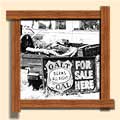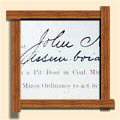 Heritage Community Foundation Presents
Heritage Community Foundation PresentsAlberta Online Encyclopedia
 |
|||
  |
|||
|
Home>> The Industry>> Coal Mining>> Miner's Roles and Responsibilities |
|||
| Miner's Roles and Responsibilities | |||
A miner's role and responsibilities differed from one location to another and on the nature of the mining operation—whether it was a surface or underground mine. However, miners knew that no matter what the challenges there were from mine to mine, they had skills that were transferable and could work anywhere in Western Canada. The workforce was, therefore, very mobile and, as one mine was exhausted or closed for other reasons, the miners moved on to the next.
Working
as a coalminer involved a routine that was repetitious but which
was, none-the-less, demanding not only physically but also
The miner started the day at the wash-house, the place where he could change into pit clothes and get ready for the work ahead. From there, he would move to the lamp house for his lamp, the most important item he would carry into the mine. Holding his lamp, lunch box, blasting powder, pick and other supplies brought from home, the miner was ready to descend to the coalface. In the Crowsnest Pass, early coal mines usually had two entry shafts. The main entry was a large, heavily-timbered opening, where men and material moved in and out of the mine. The second "counter" entry acted as an emergency exit but mainly was designed for ventilation. Crisscrossed between the two entries was an intricate series of airways, haulage tunnels and coal cars. If the miner was lucky, he could catch an empty coal car to the area he would be working, but often he would climb to the coal face by foot, an arduous process even for the fit. Traveling to his location, the miner potentially passed pumps that removed water, if the mine was wet, and ventilation fans positioned at tunnel junctions. Once at the coalface, the miner began to work. Coal mining started at the face where men, usually in pairs, worked rooms in the seam. These men, who dug coal, loaded it onto mine cars, laid track to the face and shored and bucked the rooms, were contract miners. They were paid by the amount of coal dug, graded and weighed, or by the yard. If they drove tunnel, or set up timber and did other preparatory jobs, they were paid a set rate for each job. The contract miners were the elite of the mine labor force. They had to be proficient to earn a decent living and to protect life and limb. Men responsible for general maintenance of the mine, driving the ponies that pulled the cars, bringing the rail and timber to the contract miners, or cleaning up the grounds, were company or day men. They earned a daily wage on the basis of hours worked. They were responsible for inspecting, running and repairing the huge fans that ran constantly to pull dust and gas out of the mine and force clean air in. They operated the pumps that kept some shafts from flooding. At the surface the coal was weighed, watched over by a check-weighman elected and paid by the men. The mine car was dumped, cleaned of bone and passed over a screen. The screened coal, divided into grades or sizes, was shipped in closed boxcars to markets. Supervisors, or bosses, included the mine manager, overman, pit-boss, shift-boss, and fire-bosses. Another important figure was the mine surveyor, who surveyed the larger mine workings every three months, the smaller mines once a year.
If explosives were needed, the miner drilled holes into the
coal block with a hand-held auger. He then filled the holes with
powder, positioned the fuses, and lit them. Undercutting the
seam allowed the coal to expand into the groove during the
explosion, producing a safer and, in the end, a more efficient
blast. "Blasting from the solid," or making no cuts to allow for
coal expansion, was both dangerous and illegal because the
charge could backfire into the room to wreak its destruction
there. When the dust cleared, the men shoveled the loosened coal into the chute. "Buckers" were employed to push the coal down the chutes. When it jammed, they tried to dislodge it by prodding or kicking it. If the jam gave away suddenly, the bucker could be swept down the chute to his death. By 1918, at least seven Frank miners had died attempting to clear clogged chutes. Most miners in the Crowsnest Pass worked on contract, under which they were paid for the coal tonnage they mined. The size of the miner's pay cheque depended upon his skill. The 1907 Royal Commission inquiring into coal mining in Alberta discovered that daily wages fluctuated between $2.50 and $12.00. If there was too much dirt or rock in the coal, money was subtracted from the miner's earnings. At the same time, he could earn more if his seam was difficult to mine, or if his work area was wet. If he drove his own tunnels, erected his own lagging, placed his own brattice or performed other preparatory work, he also received additional income.
All the jobs in the mine were important, and if one person slacked, the consequences could affect the safety of all work. The miner's main responsibility was to remove coal from the seam and transport material to haulage routes. Safety was the responsibility of all miners, as each member ensured their work area was safe by timbering or bratticing. The fire boss is the underground official who oversaw safety in one district of a mine. A district contains no more than 70 men and horses and has its own ventilation system. Three hours prior to a shift, the fire boss examined gas levels, tunnels, airways and timbers for proper safety. During the shift, he twice examined his district for safety and he would fire the shots of blasting powered as required.
The timber packer responsibilities dealt with bringing in timbers to be used as supports throughout the mine. Although miners were responsible for building the supports in rooms and crosscuts, the timber packer was responsible for everywhere else, including the main and counter entries. In places in the mine where seams were too flat to allow gravity to move the coal, the bucker was employed to push coal down chutes where they could be hauled below.
Other jobs in the mines included the haulage crew, mechanics
and mine managers. |
|||
 |
|||
For more on coal mining in Western Canada, visit Peel’s Prairie Provinces.








